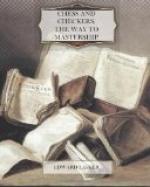Of course, it would be too difficult for the beginner to find out for himself what squares are the most favorable for the different pieces; at any rate, it would take him a long time to gain that knowledge by experience. Fortunately, the experience of the masters of several generations is accessible to us and so it is possible to expedite considerably the process by which the mind of the student is adapted to the tactics required in every game of Chess to carry out the principle of speedy development. To a great extent these tactics, too, can be simply explained from the point of view of giving the pieces their utmost mobility so that they will be readily understood by the reader who has followed the arguments given in the foregoing pages.
There is a considerable difference in the constellation of the pieces depending on whether the game is opened with (1) P-e4, P-e5 or (1) P-d4, P-d5. These two openings shall therefore be treated separately. All other openings are related to one of the above main branches and need little additional discussion.
KING’S PAWN OPENINGS
After (1) P-e4, P-e5 the only Pawn which both players have to move to enable the development of all pieces is the Queen’s Pawn, which obstructs the Queen’s Bishop. Of course, it would also be possible to secure an outlet for the Queen’s Bishop by advancing the Queen’s Knight’s Pawn one step; but in the long diagonal the Bishop is ordinarily not so well posted as the development of the Queen’s Knight to his most natural square, that is c3 or c6 respectively, would block the way of the Bishop. The Queen’s Knight is best placed in the c-file because on the edge of the board, in the a-file, he has less mobility; less squares are accessible to him. In order to place him in the d-file it would be necessary to move the d-Pawn, and as this would also give an opening to the Queen’s Bishop the move of the Queen’s Knight’s Pawn is superfluous.
Before moving the Queen’s Pawn the players will have to make sure that in advancing him they will not block the way of any piece. Consequently, White will not play P-d3 on his second move. He will first develop the King’s Bishop. Of course, he will not place him on d3, obstructing the Queen’s Pawn and thereby the Queen’s Bishop. Neither will he play B-b5, as Black could drive him away from there immediately with P-c6, opening another diagonal for the Queen. The choice between the remaining squares, e2 and c4, is not difficult. On e2 the Bishop would be in the way of the Queen and his way would soon be blocked by the King’s Knight, who for similar reasons to those given for the move of the Queen’s Knight will go to f3 in preference to other squares. Therefore, the only move to be considered in case the King’s Bishop is played at this early stage of the game, is B-c4.




